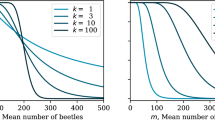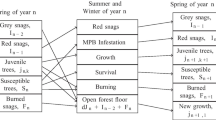Abstract
The mountain pine beetle (MPB, Dendroctonus ponderosae), a tree-killing bark beetle, has historically been part of the normal disturbance regime in lodgepole pine (Pinus contorta) forests. In recent years, warm winters and summers have allowed MPB populations to achieve synchronous emergence and successful attacks, resulting in widespread population outbreaks and resultant tree mortality across western North America. We develop an age-structured forest demographic model that incorporates temperature-dependent MPB infestations. Stability of fixed points is analyzed as a function of (thermally controlled) MPB population growth rates and indicates the existence of periodic outbreaks that intensify as growth rates increase. We devise analytical methods to predict outbreak severity and duration as well as outbreak return time. After incorporating a spatial aspect and controlling initial stand demographic variation, the model predicts cycle periods that fall within observed outbreak return time ranges. To assess future MPB impact on forests, we use climate model projected temperatures with our model-based approximation methods to predict potential severity of future outbreaks that reflect the effects of changing climate.













Similar content being viewed by others
References
Abatzoglou JT (2011) Development of gridded surface meteorological data for ecological applications and modelling. Int J Climatol. doi:10.1002/joc.3413
Abatzoglou JT, Brown TJ (2012) A comparison of statistical downscaling methods suited for wildfire applications. Int J Climatol. doi:10.1002/joc.2312
Alfaro RI, Campbell R, Vera P, Hawkes B, Shore TL (2004) Dendroecological reconstruction of mountain pine beetle outbreaks in the Chilcotin Plateau of British Columbia. In: Shore TL, Brooks JE, Stone JE (eds) Mountain pine beetle symposium: challenges and solutions. Natural Resources Canada, Information Report BC-X-399, Kelowna, British Columbia, pp 245–256
Amman G, Cole WE (1983) Mountain pine beetle dynamics in lodgepole pine forests: Part II population dynamics. U.S. Department of Agriculture, General Technical Report INT-145, Intermountain Forest and Range Experiment Station, Ogden, UT
Amman GD, Schmitz RF (1988) Mountain pine beetle–lodgepole pine interactions and strategies for reducing tree losses. Ambio 17:62–68
Anderson RM, May RM (1979) Population biology of infectious diseases: Part I. Nature 280:361–362
Anderson RM, May RM (1979) Population biology of infectious diseases: Part II. Nature 280(5722):455–461
Anderson RM, May RM (1982) The logic of vaccination. New Scientist 96(1332):410–415
Aukema BH, Carroll AL, Zhu J, Raffa KF, Sickley TA, Taylor SW (2006) Landscape level analysis of mountain pine beetle in British Columbia, Canada: spatiotemporal development and spatial synchrony within the present outbreak. Ecography 29(3):427–441
Axelson JN, Alfaro RI, Hawkes BC (2009) Influence of fire and mountain pine beetle on the dynamics of lodgepole pine stands in British Columbia, Canada. For Ecol Manag 257:1874–1882
Bentz BJ, Logan JA, Amman GD (1991) Temperature dependent development of the mountain pine beetle (Coleoptera: Scolytidae), and simulation of its phenology. Can Entomol 123(1083):1094
Bentz BJ, Mullins DE (1999) Ecology of mountain pine beetle (Coleoptera: Scolytidae) cold hardening in the Intermountain west. Environ Entomol 28(4):577–587
Bentz BJ, Régnière J, Fettig CJ, Hansen EM, Hayes JL, Hicke JA, Seybold SJ et al (2010) Climate change and bark beetles of the western United States and Canada: direct and indirect effects. BioScience 60(8):602–613
Berryman AA, Dennis B, Raffa KF, Stenseth NC (1985) Evolution of optimal group attack, with particular reference to bark beetles (Coleoptera: Scolytidae). Ecology 898:903
Bleiker KP, O’Brien MR, Smith GD, Carroll AL (2014) Characterisation of attacks made by the mountain pine beetle (Coleoptera: Curculionidae) during its endemic population phase. Can Entomol 146(03):271–284
Heath R, Alfaro RI (1990) Growth response in a Douglas-fir/lodgepole pine stand after thinning of lodgepole pine by the mountain pine beetle: A case study. J Entomol Soc B. C. 87:16–21
Heavilin J, Powell J (2008) A novel method for fitting spatio-temporal models to data, with applications to the dynamics of mountain pine beetle. Nat Res Model 21:489–524
Heavilin J, Powell JA, Logan JA (2007) Development and parametrization of a model for bark beetle disturbance in lodgepole forest. In: Miyanishi K, Johnson E (eds) Plant disturbance ecology. Academic Press, New York, pp 527–553
Hrinkevich K, Lewis KJ (2011) Northern range limit mountain pine beetle outbreak dynamics in mixed sub-boreal pine forests of British Columbia. Ecosphere 2(10):116. doi:10.1890/ES11-00150.1
Kermack WO, McKendrick AG (1927) A contribution to the mathematical theory of epidemics. Proc R Soc A 115(772):700–721. doi:10.1098/rspa.1927.0118
Kurz WA, Dymond CC, Stinson G, Rampley GJ, Neilson ET, Carroll AL, Ebata T, Safranyik L (2008) Mountain pine beetle and forest carbon feedback to climate change. Nature 452:0028–0836
Leslie PH (1945) The use of matrices in certain population mathematics. Biometrika 33(3):183–212
Meddens AJH, Hicke JA, Ferguson CA (2012) Spatiotemporal patterns of observed bark beetle-caused tree mortality in British Columbia and the western United States. Ecol Appl 22(1876):1891
Powell JA, Bentz BJ (2009) Connecting phenological predictions with population growth rates for an outbreak insect. Landsc Ecol 24:657–672
Powell JA, Bentz BJ (2014) Phenology and density-dependent dispersal predict patterns of mountain pine beetle (Dendroctonus ponderosae) impact. Ecol Model 273:173–185
Régnière J, Powell J, Bentz B, Nealis V (2012) Effects of temperature on development, survival and reproduction of insects: experimental design, data analysis and modeling. J Insect Physiol 58:634–647
Régnière J, Bentz B (2007) Modeling cold tolerance in the mountain pine beetle, Dendroctonus ponderosae. J Insect Physiol 53:559–572. doi:10.1016/j.jinsphys.2007.02.007
Safranyik L (2003) Mountain pine beetle epidemiology in lodgepole pine. In: Mountain pine beetle symposium: challenges and solutions. Natural Resources Canada, Canadian Forest Service, Pacific Forestry Centre, Victoria BC V8Z 1M5, pp 33–40
Safranyik L, Shrimpton DM, Whitney HS (1975) An interpretation of the inter-action between lodgepole pine, the mountain pine beetle and its associated blue stain fungi in western Canada. In: Baumgartner, DM (ed) Management of lodgepole pine ecosystems: Proceeding of the Symposium on the Washington State University. Cooperative Extension Service, pp 406–428
Schmidt WC, Alexander RR (1985) Strategies for managing lodgepole pine. In: Baumgartner DM, Krebill RG, Arnott JT, and Weetman GF (ed) Lodgepole pine—the species and its management, Office of Conferences and Institutes, Cooperative Extension, Washington State University, Pullman, WA, pp 202–210
Sharpe PJH, Curry GL, DeMichele DW, Cole CL (1977) Distribution model of organism development times. J Theor Biol 66:21–38
Thomson AM, Calvin KV, Smith SJ, Kyle GP, Volke A, Patel P, Delgado-Arias S, Bond-Lamberty B, Wise MA, Clarke LE et al. (2011) RCP4.5: a pathway for stabilization of radiative forcing by 2100. Clim Change. doi:10.1007/s10584-011-0151-4
Acknowledgments
Funding was provided by the USDA Forest Service, Western Wildland Threat Assessment Center and National Science Foundation, DEB 0918756. The authors would like to thank Dr. Barbara Bentz, USDA-FS Rocky Mountain Research Station, as well as three anonymous reviewers, who read an earlier draft and provided much helpful commentary.
Author information
Authors and Affiliations
Corresponding author
Rights and permissions
About this article
Cite this article
Duncan, J.P., Powell, J.A., Gordillo, L.F. et al. A Model for Mountain Pine Beetle Outbreaks in an Age-Structured Forest: Predicting Severity and Outbreak-Recovery Cycle Period. Bull Math Biol 77, 1256–1284 (2015). https://doi.org/10.1007/s11538-015-0085-5
Received:
Accepted:
Published:
Issue Date:
DOI: https://doi.org/10.1007/s11538-015-0085-5




